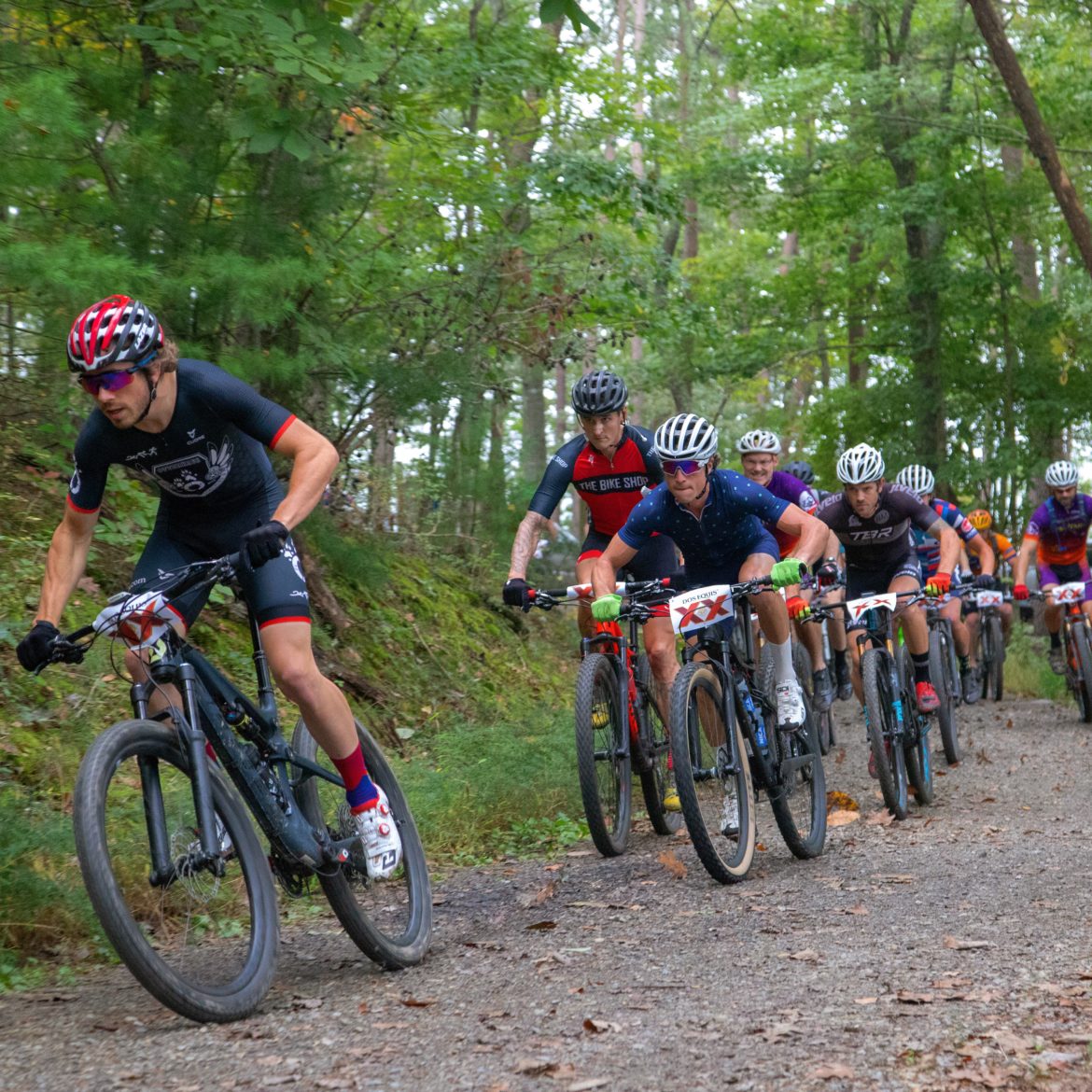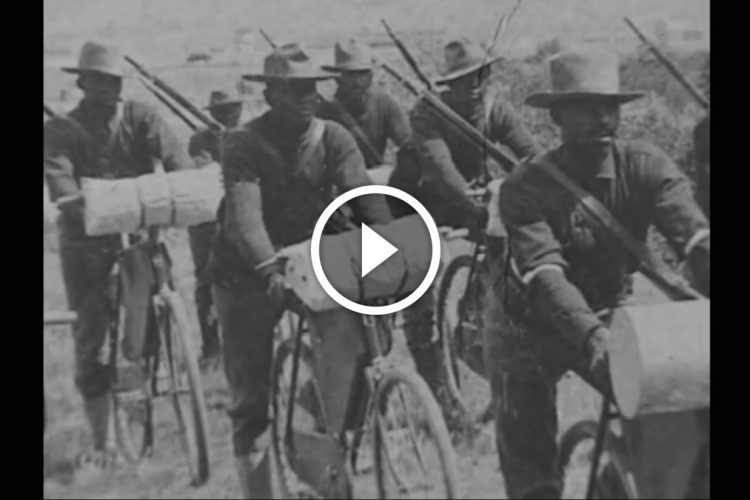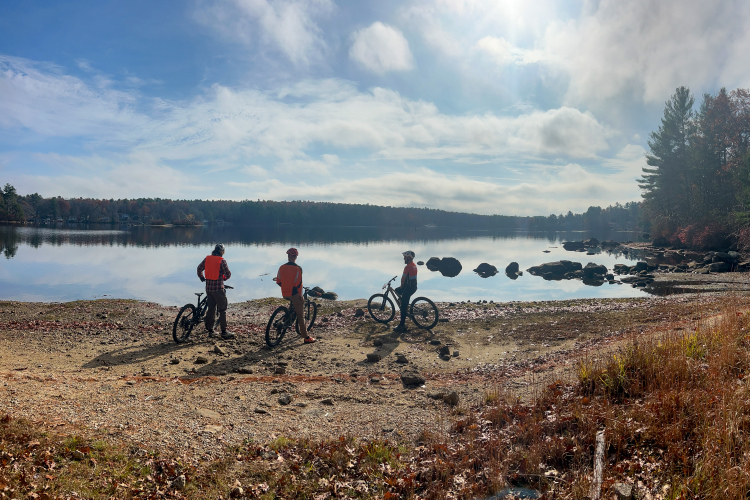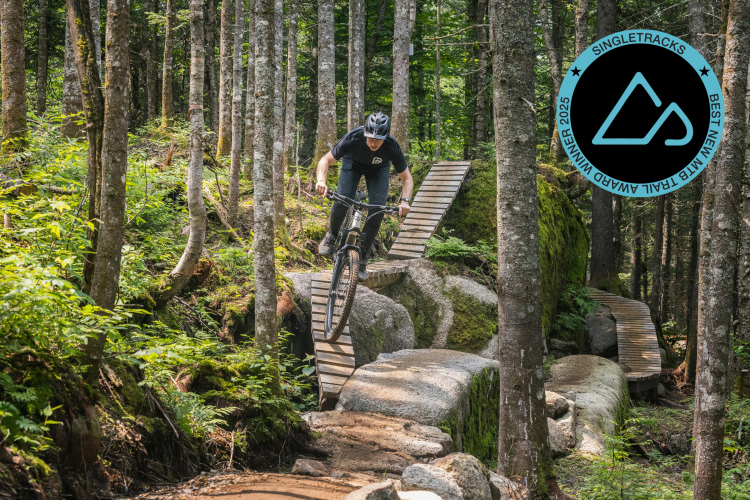
You may have passed someone riding in your area wearing a US Armed Forces jersey. Often folks wear the kit in support of military members, but did you know that a select few of them are elite-level athletes on the United States Armed Forces Cycling Team?
The US Air Force, Army, Coast Guard, and Navy each support their own teams and clubs that participate in various events, though they are not necessarily related to the Armed Forces Cycling Team.
While most of the USAF Team is focused on road and time-trial racing, there are a handful of athletes who race dirt. We recently contacted the team directors and two USAF mountain bike athletes to share their stories. The larger USAF Team history and narrative exists in the memories of athletes and team administrators. We hope that one day someone can compile the novel necessary to paint a complete picture. For now, we will color in a corner of the mural.
A brief history of the US Armed Forces Cycling squad
Each branch of the US Military has one or more members on the US Armed Forces (USAF) Cycling team, with a typical annual roster of 8-10 athletes. The primary focus of the team, according to director sportif Commander George Ganoung, is participation in CISM (World Military Championships).
“The team is primarily run like a national team program where we assemble for CISM competition and riders normally ride for ‘trade’ teams or local clubs the majority of the time. We pull together for worlds and occasionally a few prep competitions. We did have a period during the late 90s to mid-2000s where we attempted different variations of a year-round team.”
The abbreviation, CISM, mentioned above, stands for the International Military Sports Council. The US was the eighth country to join the CISM, after Belgium, Denmark, France, Luxembourg, Netherlands, Egypt, and Argentina. After the USSR dissolved in 1991 a large influx of nations joined the World Games, and the number has grown steadily since.
The CISM motto is “Friendship through Sport,” and for the past 70 years, the Belgium-based organization has been bringing together military athletes from 134 different countries to compete in a vast variety of sports. Sport has been recognized as a useful motivator for peace, and CISM has taken that idea and run with it.
The first Military World Championships men’s cycling event was held in Vincennes, France in 1972 and included athletes from 12 distinct nations. In recent years CISM events have hosted several thousand international service members, and the largest turnout for a cycling competition was the 1996 event held in Sembach, Germany, with a showing of 185 racers.
The year 2013 marked the first women’s cycling event in the World Military Championships, where 17 athletes from 7 nations competed for the top step.

Riders who may have otherwise met in combat come together for a competition between the best military athletes from each participating nation. The Military World Games are the second largest sports festival in the world behind the Olympics.
The USAF Team riders are stoked that cycling is included in the 2019 games, as not all sports are included in every edition. Dirt-focused racing has been less popular in recent years, and the 2019 games in China will only include road and time trial events. Sports and disciplines included in the games are selected by the host nation. The last mountain bike event took place in Slovenia in 2018, though no US riders competed in that championship.
We asked Ganoung about the future of the USAF squad, and he mentioned that the task of getting talented riders together is difficult, as road racing has plateaued in popularity. People would rather ride gravel, or go ride hard with friends outside of competition.
Riders on the USAF team typically have to be Cat 1 (the top USA Cycling level) on the road, which for most riders means strict 15-20hr training weeks, working with coaches, and power meters. The number of people willing to commit that kind of time and energy, who also happen to serve in the military, is not growing.

Ganoung raced with the USAF team as a time trial specialist from 2004-2010 and now volunteers as the acting director sportif alongside his colleague, manager and road racer Debra Ponzio.
Ganoung speaks fondly of the opportunities the USAF team afforded him; to race his bike all around the world, often against pro level riders who were racing grand tour events. Many of the competing nations in the CISM have compulsory military service requirements, and professional athletes in those countries are often racing and training for their national military team full time throughout their service. For riders like Ganoung, that means racing alongside some of the fittest athletes in the world including some who compete in World Cup races, and even the Giro Di Italia. For many on the USAF team, this has been a major incentive. Racing “over your head” will make you a faster rider upon your return to civilian competition back home.
In addition to his duties as DS for the team, Ganoung now owns and runs a successful coaching business called Otterhaus Coaching in West Virginia.
Below are brief outlines of two former professional mountain bikers who raced for the USAF Cycling Team on and off-road. Responses have been edited for clarity.
Captain Michael Gallagher

Singletracks What was your initial motivation or interest in joining the US Army, and how long did you serve?
Gallagher I was initially interested in the military like many other soldiers I came to know. It was the G.I. Bill, the opportunity to go to college thereafter and solid training from the military as well. I ended up enlisting just after high school as a medical specialist in the U.S. Army, in 1992. I recently retired at the rank of Captain as a signal officer in April of this year, 2018.
Singletracks How did you get started with the USAF Cycling Team?
Gallagher That’s a good question. As I think back throughout my military career I’ve been able to weave cycling in its many disciplines, into my military service. As I progressed and increased in licensure I found out through the Army sports office that there was an all Armed Forces Cycling team.

Singletracks Were you racing bikes prior to joining the Army?
Gallagher Yes. As I think back I always liked to ride bikes around the neighborhood, no different than any other kid my age. In my senior year of high school, I was able to purchase a secondhand mountain bike which was conveniently a Specialized Stumpjumper. I really didn’t know what I had and neither did the kid that sold it to me for $75 cash.
So all throughout that school year, I would ride my bike from Margate, Florida heading East to Pompano Beach then going south to Fort Lauderdale only to turn around and make my way back home. That was my normal weekend route and at the most basic level, I absolutely enjoyed riding my bike.
Fast-forward through basic training and AIT (advanced individual training) to my first assignment in Frederick, Maryland at Fort Detrick. USAMRIID Ward 200 was where I worked.
Weather permitting, I would ride from the post the whole way up to Gambrill State Park and ride on the mountain bike trails there. Little did I know that learning how to mountain bike in the Appalachian Mountains would be so helpful in developing a well-rounded skill set for off-road riding. Those trails were extremely difficult with rocks in every direction and finesse requirements that forced riders to adapt or to suffer greatly.
Luckily for me I was an early adapter, and my skill set improved rather quickly. I do have to mention though that there were multiple trips to the emergency room for some pretty solid crashes to figure out speed, pace, and timing on those unforgiving trails. But after that learning curve was rounded there weren’t many issues thereafter.
At that point, I started as a beginner mountain biker and raced the local mid-Atlantic series. I achieved some pretty consistent top five results and was able to earn my way into the sport category. The sport MTB category in the mid-Atlantic region at that time was hotly contested by a budding star we all now know, Jeremiah Bishop, my nemesis at the time. We would often battle in some of those early races.
I received orders to transfer to Germany. I remember looking at a magazine at the post gym and found they had a US Armed Forces mountain bike racing series there. I was definitely excited, because hey, I was doing pretty good and in my mind. I thought, “let’s just keep this ball rolling.” So I reached out to one of the race organizers who had a race in Garmish, Germany. I told the gentleman if everything worked out okay I’d likely be able to make it to the race, [and that] I was really excited to be stationed in Germany.
After landing in Germany and going to reception I was assigned to the 123rd MSB, a medical support battalion located in Nierstein, Germany right next to the Rhine River. This particular unit was a definite change from the office-like environment that I came from. There are many days where [work] was 6a to 6p, and when that wasn’t the case we felt like we were winning. I was able to make it out [for a spin] with another rider that I met who happened to be assigned to another unit on post. We carpooled down to Garmish. I’ll never forget driving south from Munich and just seeing the Alps rise out of the ground. The realization that those are really mountains, and the mountains that I have been racing on previously were just hills in comparison to what I saw there.
All I remember is having such an amazing time racing my bike in the mountains [and] all around in the crisp mountain air. The course did me well. There were a lot of finesse sections that were giving folks problems.
If I member correctly I got third. Funny thing was I was just so awestruck by everything that I don’t think it sunk in. The result that is. [Also] the fact that that the competition was the highest [level] at that race. Because of the venue, and because of the draw, there were participants coming from all posts in Europe to race there.
It was pretty cool to know that there was a US Army/Air Force Europe sponsored mountain bike race series. Now [after that event] the operational tempo of my unit was quite high and I believe I only ended up doing one or two more events over the next number of years as deployments and training exercises dominated the available time.


Singletracks You raced primarily in Germany, is that correct? Can you tell us some differences you noticed while racing in Europe vs. the US?
Gallagher For sure! I think the US does a great job with grassroots, lower category events. When I was in Germany and Europe I did notice an absence of multiple categories at most events. Now that may have been because I wasn’t looking or that those events were earlier in the day but I will say for road racing there are not many unlicensed events. Mountain biking and cyclocross definitely had more support for younger riders and more women’s categories. At the road events, there was normally one licensed women’s category and multiple licensed men’s races. At a really big race, there may be an under-23 or Junior race and that was about it.
Most events were similar to those in the US. For example, the club or multiple clubs would put on an event that would be underwritten or sponsored by the Bund Deutsche Radfarer (BDR), the German national cycling Federation. In all the other surrounding countries it was predominantly the same.
One thing I really did enjoy was that there seemed to be a showering requirement at mostly every venue/event. It was great; you’d throw down as hard as you could and knew that there was a shower somewhere awaiting you, regardless of how you did. These were normally located at a school or local fitness center.
I can say that the cost to race was definitely lower. Most races were €10-€15.
I experienced more respect and prestige as a cyclist in Europe as the sport had a larger support base and understanding in the populace or communities where I lived and competed.-MG

Singletracks Having raced on military and civilian teams, what are some of the differences you experienced between the two?
Gallagher Surprisingly, both the military and civilian teams that I raced with were highly organized, as one would expect. The one part that was quite interesting at times was when I was on the German team, VC Frankfurt 1883, there was not a lot of concern that I couldn’t speak German at the time.
Singletracks.com Were there any racers or other team staff that stood out to you or taught you some important things during your time racing with the USAF squad?
Gallagher When you go to the higher levels of international competition and represent your country’s military at a cycling competition, there must be an understanding that you will compete against individuals that are part of other countries’ military that are essentially not voluntary like our military. Conscript military service for many countries brings in pro tour cyclists to military cycling events who have competed at the highest levels. With that caliber of athlete available to compete against, it’s humbling to see the level that can be achieved by a non-professional.
What I’ve learned most has been from my peers: carve out time where you can, train when you can, keep the passion and fire for the sport.
Be reasonable, with the understanding that we get to do this sport and recognize that the military can be exceptionally unforgiving in what it asks of you and your family, but that service to the nation is truly the highest calling.
I’d say one of the statements that I’ve constantly repeated to others has come from one of our coaches and support staff members, Klaus Wolf. I’ve heard him say it to multiple athletes and it goes like this, with details specific to the athlete, “you didn’t do that (whatever the achievement was) by accident” is what he’d say. [Then he would] follow up with something along the lines of, “Michael, you didn’t accidentally finish in that position.”
He is always bringing to light the fact that you put in the hard work and you achieved a result and that result was reflective of all the hard work that you did. You should take that and build confidence within yourself moving forward. He said all those things in the most dry, heavy German accent that you can imagine, but it’s always stuck with me you don’t accidentally achieve things, according to Klaus Wolf.
Singletracks What is your relationship with bikes and racing today?
Gallagher Currently I race mountain bikes and am deep into the cyclocross racing season.
The other time that I spend on two wheels is commuting to and from work or out with the kids showing them that bikes are a part of who we are.
Singletracks Are you still active with the USAF team?
Gallagher My last activity with the team was in 2015 at the CISM World Military Summer games in Mungyeong, South Korea as a member of the road cycling team. I’m still somewhat active but now that I’m recently retired I’ll pass my slot and knowledge onto the next generation of military cyclists.
Staff Sergeant David Flaten

Singletracks What was your initial motivation or interest in joining the Air Force?
Flaten I don’t really have a great answer for why I joined the Air Force, but all I know is that joining was one of the best decisions I made at that point in my life.
I [left the military] as a Staff Sergeant after 7 years and 29 days of Active Duty. My occupations over those 7 years included Protective Services Team Member for a Distinguished Visitor (DV) Detail Team that provided inner and outer perimeter security for our Nation’s leaders, as well as International leaders. From there I was a full-time Athlete for the Air Force World Class Athlete Program for roughly 20 months, and then onto Dover Air Force Base where I was a certified Response Force Leader at the Security Forces Squadron. Basically providing Law Enforcement, and Security to the base’s assets.
Singletracks How did you initially get started with the USAF race program? Were you racing bikes prior?
Flaten I heard about the World Class Athlete Program during my first few months while I was stationed in Washington, DC. I had been racing my bike since 2007 and had always dreamed of racing at the professional level. I decided to spend almost all of my time off from work training and racing. My leadership was supportive, however they spared no opportunity to remind me that the chances of making the World Class Athlete Program were slim. No one in my immediate chain of command had ever met someone who had been accepted in the past, but I wasn’t discouraged. Some might call it laser-sharp focus, but I’d consider it dumb luck with a little bit of grit and hard work.

Singletracks Have you raced the Military World Championships or other international events with the USAF team?
Flaten The only Military Worlds event I competed in was the 2013 Military Mountain Bike World Championships in Leopoldsburg, Belgium. The course was built on a tailings hill from a mining operation I believe.
It was hot, completely exposed, and I felt like crap. My good friend Chuck and I started in the back row, and we both rounded out the top 10 with a 9th and 10th place finish. I wasn’t satisfied, but it did fuel some hunger to make a return trip to Europe. While I was in the World Class Athlete Program I competed in several World Cups, along with International Stage races in various countries while representing the US National Team, and the US Air Force.
Singletracks What are some differences between the military and civilian teams you have raced with?
Flaten The only civilian team I’ve raced for is Otterhaus Coaching and Racing. I balance a multi-faceted role with Otterhaus as not only a racer, but a coach as well. Otterhaus has been able to provide support for basic expenses but the biggest difference would be the Non-Appropriated funding pool of the US Air Force World Class Athlete Program. Racing World Cups in Europe with bike, wheel, nutrition, and component sponsors is a pretty stout contrast.

Singletracks Are there racers or other team staff who stood out to you or taught you some important things during your time racing with the USAF squad?
Flaten Where to begin… George Ganoung, Sean Coleman, Stokely Samuel, Kristi Contardo, Steve Brown, Rande Darnell, and Roderick Rubin are the first that come to mind. Each of these people had an immeasurable impact on my successes and progression not only just within my cycling career, but within my professional and personal life. I don’t know how I could ever repay these people for the work they contributed. Thank you!
Singletracks How did training work into your military schedule?
Flaten While I was working DV Details in Washington DC we had a pretty good work schedule that allowed lots of big miles on the bike. I was able to race pretty much every other weekend and had chances to make trips to some mountains in Harrisonburg for some added fun.
Singletracks What is your relationship with bikes and racing today? Are you still active with the USAF team?
Flaten While balancing a slow but forward moving coaching career, and full-time studies in Kinesiology at James Madison University, it’s tough to find a realistic option for making it back to the high level I was at. My relationship with my bike includes a much more relaxed approach these days. I get to live in Harrisonburg, Virginia and get to ride some of my favorite roads and trails with my friends.

Singletracks How did being an athlete affect your overall military experience?
Flaten The Athlete Program had many positive and negative aspects on my military career. I got to ride my bike every day, push the limits of my body, and travel the world. That was a pretty sweet deal and was only possible with the support of the Air Force Athlete Program. I believe the fact that it is so difficult to get into the program gave some of my work validation to those who were critical of my pursuit of the program instead of getting my Community College of the Air Force Degree like so many of my peers had done. I received a mark down on my first [performance review] for this exact reason and yet, I would do it all over again.
But with anything in life, you’re going to have people who build you up, and others who are less supportive. Racing my bike full time for two seasons didn’t do me any favors when it came time to return to my primary career field of Security Forces at Dover Air Force Base. It was tough to have accomplished a dream of racing and training full time, and then having that taken away.
The first day back to Dover I found myself in the exact same place that I was on the very first day as a brand new Airman at Andrews Air Force Base, and that was checking ID cards at the main gate. That was a tough battle and difficult to accept the situation to have been rocking the Team USA jersey in Europe, to performing one of the less glamorous jobs that an Airman could have. It was somewhat poetic, but not the Disney-movie style. More of the hard, sharp, and specific introduction to “life ain’t all sunshine and rainbows” rock-bottom-kind of poetry.
The USAF Athlete Program is something great that someone can aspire to accomplish. I hope it sticks around forever, and grants similar if not better opportunities to motivated, and dedicated Airman who are pursuing Athletic Excellence. -DF

The majority of military personnel and veterans we spoke with about the USAF Team hadn’t heard of the squad, further underlining the need for this story to be told. We would like to thank George Ganoung, Michael Gallagher, and David Flaten for taking the time to share their stories with our readers. If you would like more information on the USAF Cycling Team you can find a smattering of resources here.











1 Comments
Dec 5, 2018